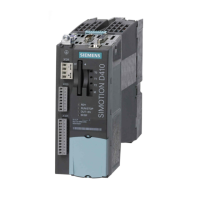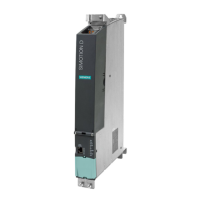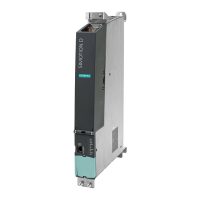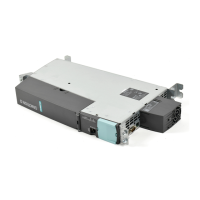Do you have a question about the Siemens SIMOTION and is the answer not in the manual?
Provides an overview of the manual's content and structure.
Lists available SIMOTION documentation packages and resources.
Details safety precautions related to electromagnetic fields (EMF) during operation.
Provides guidelines for safely handling electrostatic sensitive devices (ESD) to prevent damage.
Covers security measures for protecting plants, systems, and networks against cyber threats.
Warns about risks to life from software manipulation and using removable media.
Outlines residual risks associated with control and drive components in power drive systems.
Provides an overview of the SIMOTION C system architecture and capabilities.
Lists and describes I/O modules approved for use with SIMOTION.
Explains the basic principles of motion control for servo and stepper axes.
Details the physical layout and interfaces of the SIMOTION C modules.
Explains the information presented on the SIMOTION C module type plates.
Compares the different versions of the SIMOTION C motion controller.
Describes the function and positions of the mode selector for operating modes.
Details the Micro Memory Card (MMC) requirements and usage for SIMOTION C.
Explains the status and error indicators provided by the LEDs on the SIMOTION C.
Describes the various interfaces available on the SIMOTION C module.
Details the Ethernet interface functionality, connection, and assignment.
Explains the PROFINET interface capabilities, connection, and configuration for C240 PN.
Covers the PROFIBUS DP interfaces, their connection, and configuration.
Details the onboard drive interface, its connectors, and signal assignments.
Describes the onboard measuring system interface for encoders and counter inputs.
Explains the application possibilities for the drive and measuring system interfaces.
Details the front connector and I/O interface for digital inputs/outputs.
Covers general requirements for designing and preparing SIMOTION C components for installation.
Provides guidelines for configuring the physical installation of SIMOTION C modules.
Details the procedure for installing mounting rails for SIMOTION C modules.
Explains how to fit modules onto the mounting rail, including accessories.
Outlines basic rules and safety regulations for electrical wiring of SIMOTION C.
Covers rules for system startup, supply voltage, and 24 VDC supply.
Shows wiring diagrams for connecting SIMOTION C to various drives and systems.
Details how to connect drive units to the SIMOTION C using analog, digital, or PROFINET interfaces.
Explains how to connect encoders to the SIMOTION C module.
Guides on wiring the front connector and suppressing line interference.
Describes how to connect shielded cables using a shield connecting element for interference suppression.
Covers PROFIBUS subnet configuration, addresses, rules, and components.
Details configuration of Ethernet subnets, including IP address loading.
Explains PROFINET subnet configuration and IP address loading for C240 PN.
Explains default address allocation based on module slots for centralized I/O.
Describes how to assign addresses to modules or slots for flexible addressing.
Details addressing for signal modules, including digital and analog types.
Explains the default start addresses of onboard digital inputs/outputs.
Covers addressing for the onboard drive and measuring system interfaces.
Lists prerequisite actions and system requirements for commissioning the SIMOTION C.
Provides procedures for inserting and changing the Micro Memory Card.
Outlines requirements and steps for the initial power-on sequence.
Details how to write, format, and erase data on the Micro Memory Card.
Explains the SIMOTION C memory model and user memory organization.
Covers methods for deleting data, including memory reset and factory settings.
Explains the process and data affected by a SIMOTION C memory reset.
Details how to restore SIMOTION C to its factory default settings using the mode selector.
Provides instructions for updating the SIMOTION Kernel for C230-2 and C240/C240 PN.
Details the procedures for removing and installing SIMOTION C modules.
Explains how to replace a defective module without needing a PG/PC.
Explains how to diagnose system status and faults using the diagnostic LEDs.
Provides a summary of LED display combinations for various operating states and faults.
Lists memory sizes for system data like diagnostic buffer and RAM.
Details system clock timings for basic, DP, and position control cycles.
Outlines the address areas for inputs, outputs, and process images.
Provides electrical connection values like supply voltage and power consumption.
Lists the physical dimensions and weight of the SIMOTION C.
Presents technical data for the analog output and controller enable signals of the drive interface.
Details technical specifications for stepper drives, including output signals and cable length.
Provides technical data for the onboard measuring system interface, including signal voltages and cable lengths.
Lists specifications for digital inputs, including number of inputs and voltage requirements.
Lists specifications for digital outputs, including number of outputs and voltage requirements.
Describes the properties and functions of the SIMOTION C's real-time clock.
Outlines permissible conditions for transporting and storing the SIMOTION C.
Details environmental conditions for operating the SIMOTION C, including temperature and humidity.
Provides specifications for dielectric tests, safety class, and protection against foreign matter.
Shows the physical dimensions of the SIMOTION C module.
Lists available spare parts and accessories for the SIMOTION C.
Covers general compliance information such as CE marking and cULus approval.
Details residual risks associated with power drive systems and safety measures.
Explains what Electrostatic Discharge (ESD) means and its potential for damage.
Provides essential measures for protecting against static electricity discharge.
| Power Supply | 24 V DC |
|---|---|
| Interfaces | PROFIBUS, PROFINET, Ethernet |
| Product type | Control Unit |
| Series | SIMOTION D |
| Display Output | VGA |












